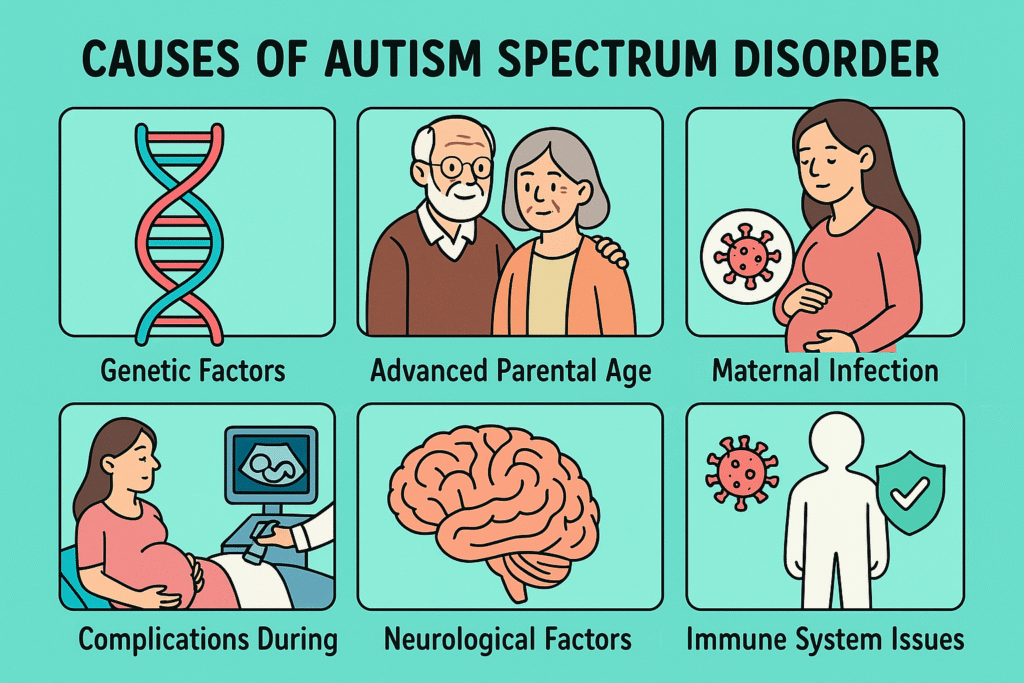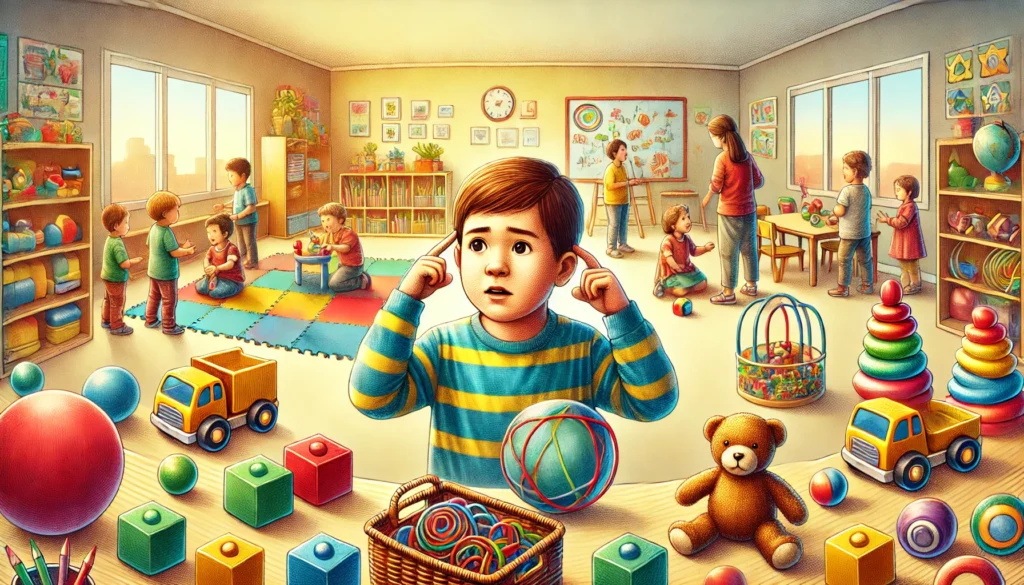Summary
- Autism Spectrum Disorder (ASD) is a developmental condition affecting communication, social skills, and behavior.
- Key symptoms include difficulty with social interactions, repetitive behaviors, and restricted interests.
- Treatment focuses on therapies such as behavioral, speech, and occupational interventions to enhance skills.
Introduction
Autism Spectrum Disorder (ASD) is a complex condition related to brain development that impacts how a person communicates, interacts with others, and behaves.
ASD is called a “spectrum” because it shows a range of symptoms and severity, from mild to severe.
Symptoms usually appear before the age of three, and while it can influence people from any race, ethnicity, or income level, boys tend to be diagnosed more often than girls.
Key traits of ASD include struggles with social communication, repetitive behaviors, and a strong preference for routines.
Causes
The true cause of autism is not entirely known, but studies suggest it arises from a mix of genetic, environmental, and brain-related factors.
1. Genetic Factors:
Genetics has a big part in autism’s development. Research shows that ASD can run in families and that certain genetic changes can increase the chance of autism.
No one gene has been marked as the direct cause, but it is thought that many genes working together with environmental influences lead to the condition.
Some genes involved with ASD affect brain growth and how brain signals function.
2. Environmental Factors:
Factors during pregnancy or in early life may help in developing ASD in those with a genetic risk. These include:
- Maternal infections: Certain viral infections like rubella during pregnancy may raise the autism risk for the child.
- Advanced parental age: Kids born to older parents, especially older fathers, may have a higher chance of developing autism.
- Prenatal exposure to toxins: Being exposed to certain harmful substances, such as pesticides or heavy metals, during pregnancy might heighten the autism risk.
- Complications during pregnancy or childbirth: Issues such as gestational diabetes, premature birth, or low birth weight may link to a greater autism risk.
3. Neurological Factors:
Abnormalities in the brain structure and its functions are associated with ASD.
Some research indicates that people with autism might have different brain sizes and connections in particular areas, such as the frontal lobe, amygdala, and cerebellum, which could lead to their social and behavioral challenges.
3. Immune System Issues:
Some studies propose that the immune system might influence autism development.
It is suggested that strange immune reactions during pregnancy or early childhood could harm brain growth, which might lead to ASD.

Symptoms
The symptoms of autism can differ a lot from person to person in both type and severity. The main symptoms of ASD generally fall into two primary categories: social communication and interaction, and restrictive and repetitive behaviors.
1. Social Communication and Interaction:
Challenges with verbal and non-verbal communication: People with autism might find it hard to speak, understand language, or read non-verbal signals such as Body language or facial feelings.
Limited eye contact: Many people with ASD avoid looking at others or have trouble keeping eye contact in talks.
Struggles in making friends: Kids with ASD often find it hard to make friends or join normal social activities. They might not seek out or react to social situations like other kids do.
Not getting social rules: People with autism might not comprehend social rules, such as taking turns when talking or respecting personal space.
2. Restrictive and Repetitive Behaviors:
Repeated actions or speech: Common actions include flapping hands, rocking back and forth, or saying the same phrases or sounds repeatedly.
Strict routines: Those with autism may become upset if their daily schedules change or if they need to move to a new place.
Strong interest in a few topics: Some individuals with ASD may focus intensely on specific subjects or items for long times, often ignoring everything else.
Sensory issues: Many people with autism are overly or under-sensitive to sensory experiences, like light, sounds, textures, or smells.
3. Cognitive and Learning Differences:
Different intellectual abilities: While many with autism have learning challenges, others might have average or higher intelligence. Some may show special talent in areas like math, art, or music.
Late speech development: Some autistic children may not speak until later, and others might not speak at all. Early speech delays are usual in ASD.
Struggles with planning and organization: Individuals with autism may have issues with skills such as planning, organization, and managing time.
4. Other Associated Symptoms:
Additional health issues: Many individuals with autism might also have other health problems, including anxiety, depression, ADHD, epilepsy, or stomach issues.
Sleep problems: Many children and adults with autism have trouble with sleep, including issues falling or staying asleep.
Aggression or self-harm: Some individuals with autism may hurt themselves, like hitting or biting themselves.
Risk Factors
Some factors can raise the chances of developing autism, including:
- Family Background: Having a family member with autism or other developmental disorders raises the risk of getting ASD. Studies say if one child in a family has autism, another child is more likely to have it too.
- Genetic Issues: Some genetic conditions, like fragile X syndrome, Rett syndrome, and Williams syndrome, are linked to a higher risk of autism.
- Gender: Boys are more often diagnosed with autism than girls. The reason for this difference is not fully clear but might relate to genetic or hormonal factors.
- Parental Age: Older parents, particularly fathers over 40, are linked to a higher autism risk.
- Early Birth: Babies born too early or with low birth weight have a greater risk of having autism.
- Exposure to Harmful Substances: Being exposed to certain chemicals or environmental toxins before birth, like pollution or pesticides, may increase autism risk.
Differential Diagnosis
Many conditions can look similar to autism, making it vital to tell ASD apart from other developmental or behavior disorders. These include:
- Attention Deficit Hyperactivity Disorder (ADHD): Both ADHD and autism can involve social interaction difficulties, impulsivity, and focus problems. But ADHD mainly shows issues with attention and hyperactivity, while autism features may vary. Children often have difficulties with communication and social interaction.
- Language Disorders: Kids with language disorders might have delayed speech and struggle with communication, which can be similar to autism. But language disorders usually do not involve the broader social and behavioral issues seen in autism.
- Intellectual Disability: This condition involves cognitive challenges affecting learning and daily life skills, which can also happen in autism. However, autism includes specific social and behavioral issues that set it apart from other cognitive problems.
- Social Communication Disorder: This disorder shows difficulties in social communication, like autism, but lacks the repetitive behaviors and limited interests that are common in ASD.
- Rett Syndrome: This genetic disorder mainly affects girls and leads to loss of motor and language skills. Although it resembles autism in some ways, Rett syndrome usually has more serious motor issues and unique characteristics, such as hand-wringing.
- Sensory Processing Disorder: This disorder includes challenges in processing sensory information. While sensory problems are often found in ASD, they can appear without other ASD symptoms and need careful assessment.
| Differential Diagnosis | Definition | Symptoms | Treatment |
|---|---|---|---|
| Autism Spectrum Disorder (ASD) | A developmental disorder characterized by challenges in social interaction, communication, and repetitive behaviors. | Difficulty with social communication, repetitive behaviors, restricted interests, and sensory sensitivities. | Behavioral therapy, speech therapy, occupational therapy, and educational support tailored to the individual’s needs. |
| Attention Deficit Hyperactivity Disorder (ADHD) | A neurodevelopmental disorder that affects attention, impulsivity, and hyperactivity. | Difficulty maintaining attention, impulsive behavior, and excessive activity. Social challenges may occur but are not primary. | Behavioral therapy, parent training, educational support, and medications like stimulants. |
| Language Disorders | Disorders involving delayed speech and communication issues without broader social or behavioral concerns. | Difficulty understanding or producing language; struggles with grammar and vocabulary. | Speech therapy focused on improving language skills and communication. |
| Intellectual Disability | A condition characterized by below-average intellectual functioning and limitations in adaptive behaviors. | Delays in learning and development; struggles with reasoning and problem-solving. | Educational interventions, occupational therapy, and support for daily living skills. |
| Social Communication Disorder | Difficulty with social communication without repetitive behaviors or restricted interests. | Challenges in understanding social cues, conversational skills, and appropriate social behavior. | Speech therapy and social skills training. |
| Rett Syndrome | A rare genetic disorder primarily affecting girls, leading to loss of motor and language skills. | Loss of hand skills, repetitive hand-wringing, motor difficulties, and slowed growth. | Symptom management with physical therapy, speech therapy, and medications for seizures or breathing issues. |
| Sensory Processing Disorder | Difficulty in processing sensory information, leading to over- or under-responsiveness to sensory stimuli. | Extreme reactions to sensory input, such as light, sound, or textures. | Occupational therapy with sensory integration techniques. |
Investigation
Diagnosing autism combines clinical evaluation, behavior assessment, and developmental history. The process includes:
- Behavioral Observations: A developmental pediatrician, neurologist, or psychologist observes the child, focusing on social communication, play, and language skills.
- Autism Diagnostic Observation Schedule (ADOS): The ADOS is a standardized tool for assessing social communication and behavior in suspected autism cases. It consists of structured interactions to see how the child engages socially and plays.
- Autism Diagnostic Interview-Revised (ADI-R): The ADI-R is a parental or caregiver interview to gather information on the child’s development, language abilities, and behavior patterns.
- Medical Evaluation: A full medical check-up is crucial to exclude other possible causes of developmental delays or behavior problems. This may involve blood tests, hearing tests, genetic tests, and brain scans if needed.
- Psychological and Cognitive Testing: Standardized tests of intelligence and development can help evaluate cognitive skills and detect co-existing issues, such as intellectual disabilities or language disorders.
Treatment
There is currently no cure for autism, but early interventions can greatly improve results by addressing developmental delays and boosting communication and social abilities. Treatment often includes behavioral therapies, educational support, and family assistance.
1. Behavioral and Developmental Interventions:
Applied Behavior Analysis (ABA): ABA is widely used for autistic individuals. It emphasizes reinforcing positive behaviors and decreasing unwanted ones. ABA breaks down complex activities into smaller steps and uses rewards to promote desired actions.
Speech and Language Therapy: This type of therapy aids children with autism in developing communication skills, like verbal speech, non-verbal cues (like gestures), and social communication. It is especially crucial for those with speech delays or who do not speak.
Occupational Therapy (OT): OT assists autistic individuals in developing everyday skills like dressing, eating, and personal hygiene. It can also focus on sensory issues and enhance fine motor abilities.
Social Skills Training: This therapy sort helps people with autism to interact better with peers and adults. Social skills training may involve things like role-playing, peer interactions, and techniques for understanding social rules.
Cognitive Behavioral Therapy (CBT): For kids and adults with autism who have anxiety or other mental health problems, CBT can aid in managing symptoms by tackling negative thoughts and encouraging coping methods.
2. Educational Help:
Special Education Services: Early help in schools is vital for kids with autism. Special education programs that suit the child’s specific needs create structured learning spaces that cater to sensory, cognitive, and social issues. These programs often have smaller classes, personalized education plans (IEPs), and use of assistive technologies to support learning.
Inclusion in Regular Education: Some kids with autism do better in regular classrooms, where they can learn social skills and academic skills with neurotypical peers, using support from aides or resource teachers.
3. Medications:
Even though no medication specifically targets autism, some can assist in managing related symptoms and behaviors like anxiety, depression, hyperactivity, and aggression.
Antipsychotics: Medications such as risperidone (Risperdal) and aripiprazole (Abilify) may be given to help control irritability, aggression, and repetitive actions in certain children with autism.
Antidepressants: Selective serotonin reuptake inhibitors (SSRIs) can be prescribed for anxiety and depression often found in those with autism.
Stimulants: For children with autism and attention deficit hyperactivity disorder (ADHD), stimulant drugs like methylphenidate (Ritalin) may enhance focus and lessen hyperactivity.
4. Family Help and Counseling:
Parent Training and Support: Parents of children with autism often need more help and training to address their child’s needs and manage behaviors. Parent training programs, family counseling, and support groups can assist families in dealing with the challenges of raising a child with autism.
Respite Care: Respite care offers temporary relief to caregivers, letting them take breaks while ensuring their autistic child gets care. This is important for avoiding caregiver burnout and supporting family well-being.
5. Alternative and Additional Therapies:
Dietary Changes: Some families look into dietary adjustments or supplements, like gluten-free or casein-free diets, though there’s no strong scientific backing for these as autism treatments. However, some individuals may have sensitivities to certain foods, which can be managed through dietary changes.
Sensory Integration Therapy: This therapy seeks to help individuals with autism process and respond to sensory information better. It includes organized activities aimed at challenging and improving the person’s reactions to sensory experiences, like touch, sound, or movement.
Prognosis
The outlook for individuals with autism differs greatly based on several factors, including symptom severity, the presence of intellectual disabilities, how well interventions work, and available support services.
Early Intervention: Early diagnosis and help have shown to enhance long-term results for children with autism. With suitable therapies, many children can grow better social skills, communication skills, and adaptive behaviors.
Co-occurring Conditions: Having additional conditions, such as intellectual disability, anxiety, or epilepsy, can impact overall prognosis. Kids without intellectual disabilities who receive Early and strong help can make bigger independence in adults.
Lifelong Help: Autism is a lifelong issue, and some people might still need help as grown-ups. Still, many with autism can be independent, especially with good education, job training, and social help. Some others may need ongoing care or special services all their lives.
Conclusion
Autism Spectrum Disorder (ASD) is a complicated, lifelong brain condition that affects social skills, behavior, and learning.
The exact reason for autism is not known, but a mix of genetic and environmental factors probably contributes to it. Autism symptoms differ a lot, with individuals showing a wide range of strengths and struggles.
Early diagnosis, specific interventions, and continued support are very important for helping those with autism reach their potential and live happy lives.
- American Psychiatric Association. (2013). Diagnostic and Statistical Manual of Mental Disorders (5th ed.). Arlington, VA: American Psychiatric Publishing.
- Landa, R. J. (2007). “Diagnosis of Autism Spectrum Disorders in the First Three Years of Life.” Nature Clinical Practice Neurology, 3(8), 477-485.
- Lord, C., & McGee, J. P. (2001). Educating Children with Autism. National Academy Press.
- Volkmar, F. R., & Pauls, D. (2003). “Autism.” The Lancet, 362(9390), 1133-1141.
- Johnson, C. P., & Myers, S. M. (2007). “Identification and Evaluation of Children with Autism Spectrum Disorders.” Pediatrics, 120(5), 1183-1215.
- National Institute of Mental Health (NIMH). (2020). Autism Spectrum Disorder. Available at: https://www.nimh.nih.gov/health/topics/autism-spectrum-disorders-asd


